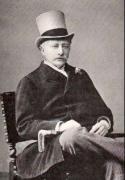|
|
||||||||||||||||||||||||
 |
Featured person
Recently added |
Edward John Cotton (1829 - 1899): |
||||||||||||||||||||||

|
| Edward John Cotton |
Edward John Cotton, the pioneer in the development of the railways in the North of Ireland, was born in Rochester in Kent in 1829. In 1841 as a young man, he came to Ireland as general manager of the Waterford and Central Railway but it was in the north of Ireland that he excelled in his achievements.
Moving with his wife, Rosina Harriott Lowe and young family in 1857, he came to live in York Street, Belfast and was appointed general manager of the Belfast and Ballymena Railway, which was still in its infancy.
In those early years of steam, Edward John saw the great potential of rail travel and under his management and guidance, the Belfast and Ballymena railway very soon owned the lines from Belfast to Londonderry and to Cookstown in the west. With the change of Company name to the Belfast and Northern Counties Railway, he introduced the “villa ticket”. It was Edward John's idea to entice Belfast merchants to build their houses within a radius of stations such as Greencastle, Whitehouse, Whiteabbey, Jordanstown and Greenisland, all bordering the shores of the Belfast Lough and far away from the industrial polluted City. These merchants would enjoy the benefit of free rail travel. So began the growth of these villages and together with the introduction of third class travel for the less wealthy, the birth of the Railway Hotels, the purchase of branch lines throughout the north and the commencement of a daily boat service from Larne to Stranraer, Edward John Cotton became the doyen of the railways throughout Great Britain and placed the North of Ireland firmly on the map.
Writing in the Railway Gazette in 1920, Joseph Tatlow, Director of the Midland Great Western Railway, said of Cotton:
I have spoken previously of the beaux I knew in the higher ranks of the railway service but, strange to say, omitted to mention Edward John who, in some respects outshone all others. His coat may not have been cut by a west-end tailor, his hat may not have been a Lincoln Bennett, or his necktie the latest production of Burlington Arcade, but who could wear a tall white hat with a black band, with the least little rakish tilt, and a light grey frock coat with a rose in the buttonhole, with such an air and grace as he appreciated keenly all the good things that life can give and loved his fellow men. Pax vobiscum, kind, warm- hearted Edward John! You were an ornament to the railway world and always my friend.
By 1865, he had moved his family to Jordanstown to live in a house called "Elsinore". Edward John was a pillar of society and was very much involved as a Churchwarden of St. Patrick's Church of Ireland, Jordanstown where there is a plaque to him inside the Church. Two of his daughters married into the linen dynasty of the Taylors of the Barn Mills, Carrickfergus. When he died on 14 June 1899 at Elsinore, the country mourned a man who was known as “The Father of Steam”.
He is buried in the City Cemetery, Belfast.
| Born: | 1 June 1829 |
| Died: | 14 June 1899 |
| Maud Hamill |


Home | Our Policies | Plaques | Browse | Search | Sponsors | Links | Help | Contact
Privacy & Disclaimer | Cookie Policy | Site Map | Website Design By K-Point
© 2024 Ulster History Circle









